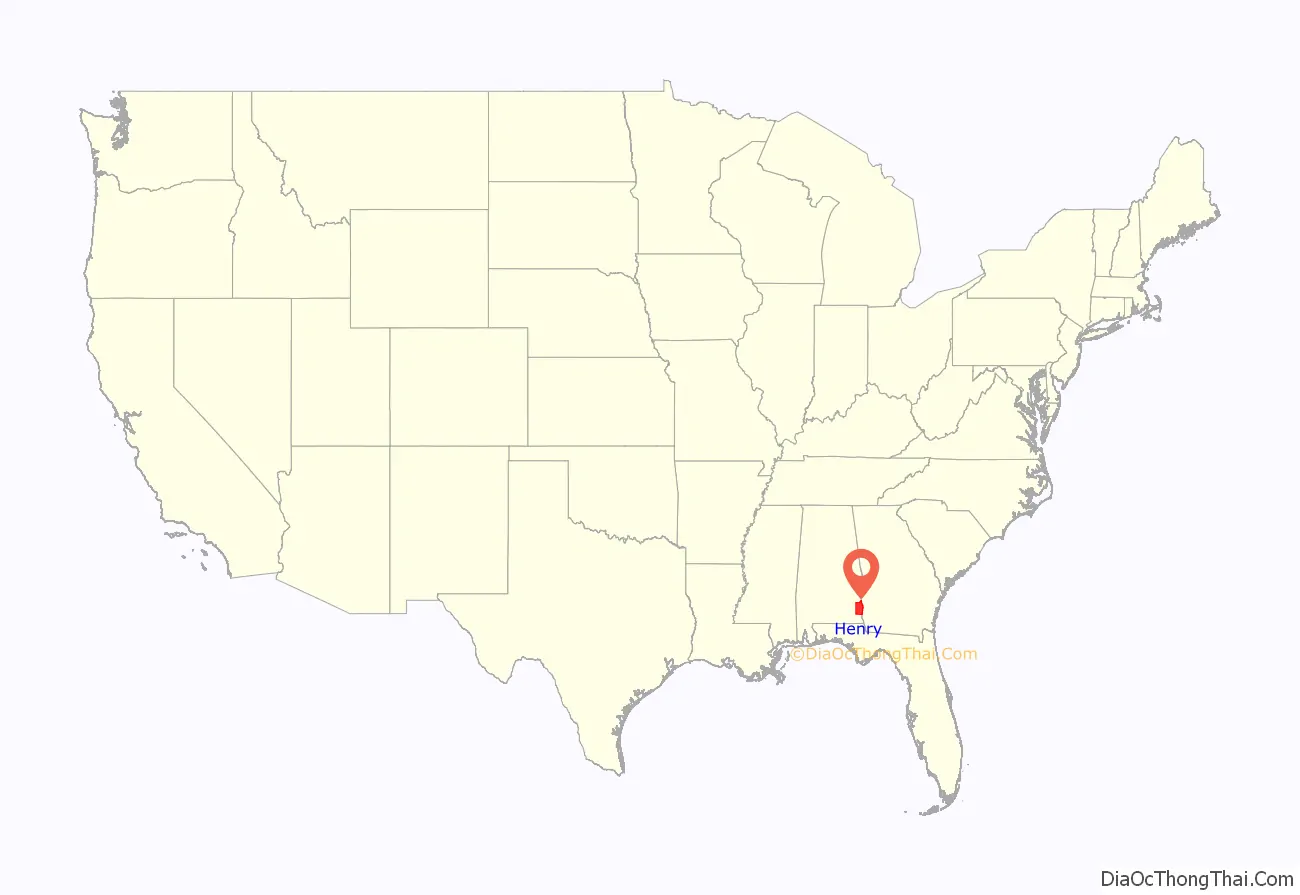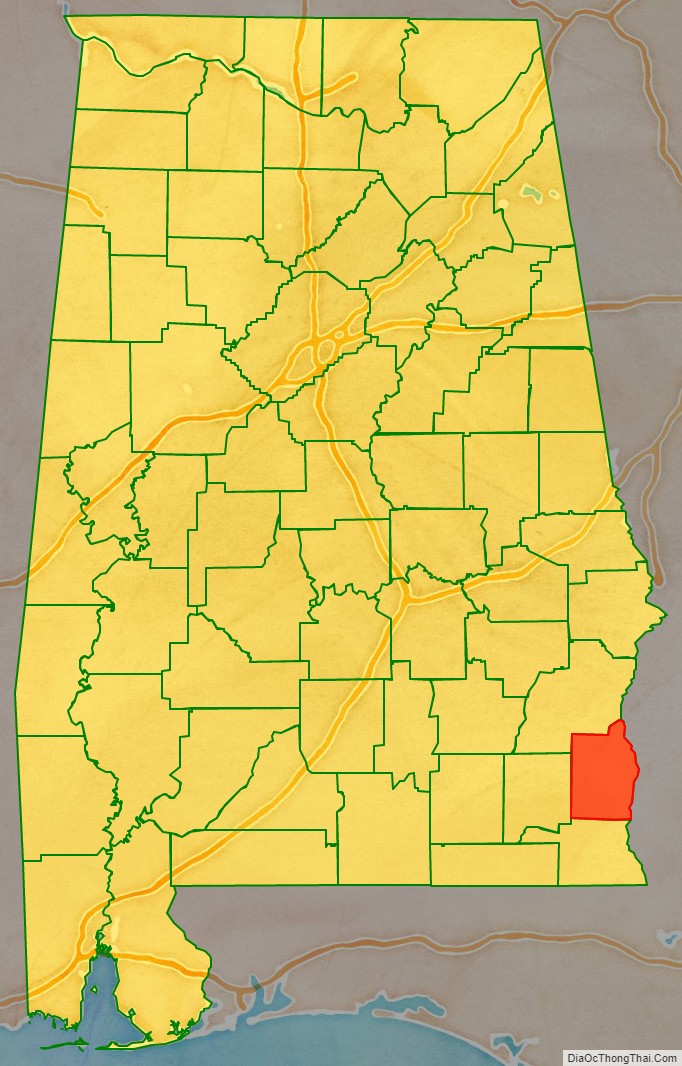Henry County is a county in the southeastern part of the U.S. state of Alabama. As of the 2020 census, its population was 17,146. Its county seat is Abbeville. The county was named for Patrick Henry (1736–1799), famous orator and Governor of Virginia.
Henry County is part of the Dothan, AL Metropolitan Statistical Area.
| Name: | Henry County |
|---|---|
| FIPS code: | 01-067 |
| State: | Alabama |
| Founded: | December 13, 1819 |
| Named for: | Patrick Henry |
| Seat: | Abbeville |
| Largest city: | Headland |
| Total Area: | 568 sq mi (1,470 km²) |
| Land Area: | 562 sq mi (1,460 km²) |
| Total Population: | 17,146 |
| Population Density: | 30/sq mi (12/km²) |
| Time zone: | UTC−6 (Central) |
| Summer Time Zone (DST): | UTC−5 (CDT) |
| Website: | www.henrycountyal.com |
Henry County location map. Where is Henry County?
History
The area that includes Henry County had historically been occupied by people of the Lower Creek Confederacy, who now prefer to be known as the Muscogee. It was occupied for thousands of years before that by varying cultures of indigenous peoples who settled primarily along the waterways.
This area was colonized by various European powers, including France and Spain. After Great Britain defeated France in the Seven Years’ War, it took over this area. Between 1763 and 1783, the area that is now Henry County, Alabama was under the jurisdiction of the colony of British West Florida. The United States acquired it from Britain after gaining independence in the American Revolutionary War.
After 1814, the territorial settlers developed Franklin as the first European-American settlement in Muscogee/Creek territory. The former river port served Abbeville on the Chattahoochee River. Much of Henry County was within the Alabama wiregrass region.
Henry County was established on December 13, 1819, by the Alabama Territorial Legislature. The area was ceded by the Creek Indian Nation in 1814 under the Treaty of Fort Jackson. Henry County was formed before Alabama was organized as a state. Abbeville was designated as the county seat in 1833.
Henry County has been called “The Cradle of the Wiregrass”. She is The Mother of nine other counties. When the county was formed December 1819, it was the largest county by area within Alabama and encompassed a vast land area that now includes the Southeast Alabama Wiregrass Region and beyond. As population increased in the region, areas of it were taken to organize the present counties of Barbour, Coffee, Covington, Crenshaw, Dale, Geneva, Houston, and Pike.
Timeline:
- December 7, 1821 – The first two counties created, in part, from Old Henry were Covington and Pike counties.
- December 29, 1824 – The third county was Dale which was carved, in whole, from Old Henry.
- December 18, 1832 – The fourth county to be created was Barbour County which was formed, in part, from Pike County. When Barbour County was created, Henry County gained a small parcel of land from the White Oak Creek area.
- December 29, 1841 – The fifth county to be created was Coffee County, which was formed in part from Dale County.
- December 6, 1866 – The sixth was Bullock County, which was created with the southern tip of the county indirectly coming from Old Henry.
- December 24, 1866 – The seventh county to be created was Crenshaw County which was formed, in part, from Coffee, Covington and Pike counties.
- December 28, 1868 – The eighth county to be created was Geneva County which was formed, in part, from Henry, Dale and Coffee counties.
- February 9, 1903 – The last county was Houston County; 72% of its land area was carved from Henry. The balance came from Dale and Geneva counties.
After Houston County was formed in 1903, Henry County had become the smallest in geographic area.
This rural county was developed for agriculture, and planters held many slaves. After Reconstruction, conservative Democratic Party whites regained power in the state legislature and passed Jim Crow laws to suppress African Americans. They also used intimidation and violence to discourage voting, as the freedmen allied with the Republican Party, which they credited with achieving their emancipation and granting of the franchise.
From 1877 to 1950, whites lynched 13 African Americans in the county, most in the decades on either side of the turn of the 20th century. Henry County is among the 805 counties where lynchings took place that is memorialized in the new National Memorial for Peace and Justice, which opened in April 2018 in Montgomery, Alabama.
Mechanization and other changes resulted in population losses, especially from 1940 to 1970, as many African Americans left in the Great Migration, seeking to escape the oppression of Jim Crow and gain work in northern, midwestern and western industrial cities.
Henry County Road Map
Geography
According to the United States Census Bureau, the county has a total area of 568 square miles (1,470 km), of which 562 square miles (1,460 km) is land and 6.6 square miles (17 km) (1.2%) is water. The county is located in the Wiregrass region of southeast Alabama.
It is the fourth-smallest county in Alabama by total area.
Major highways
- U.S. Highway 431
- State Route 10
- State Route 27
- State Route 95
- State Route 134
- State Route 173
Adjacent counties
- Barbour County (north)
- Clay County, Georgia (northeast/EST Border)
- Early County, Georgia (southeast/EST Border)
- Houston County (south)
- Dale County (west)
Henry County Topographic Map
Henry County Satellite Map
Henry County Outline Map
See also
Map of Alabama State and its subdivision:- Autauga
- Baldwin
- Barbour
- Bibb
- Blount
- Bullock
- Butler
- Calhoun
- Chambers
- Cherokee
- Chilton
- Choctaw
- Clarke
- Clay
- Cleburne
- Coffee
- Colbert
- Conecuh
- Coosa
- Covington
- Crenshaw
- Cullman
- Dale
- Dallas
- De Kalb
- Elmore
- Escambia
- Etowah
- Fayette
- Franklin
- Geneva
- Greene
- Hale
- Henry
- Houston
- Jackson
- Jefferson
- Lamar
- Lauderdale
- Lawrence
- Lee
- Limestone
- Lowndes
- Macon
- Madison
- Marengo
- Marion
- Marshall
- Mobile
- Monroe
- Montgomery
- Morgan
- Perry
- Pickens
- Pike
- Randolph
- Russell
- Saint Clair
- Shelby
- Sumter
- Talladega
- Tallapoosa
- Tuscaloosa
- Walker
- Washington
- Wilcox
- Winston
- Alabama
- Alaska
- Arizona
- Arkansas
- California
- Colorado
- Connecticut
- Delaware
- District of Columbia
- Florida
- Georgia
- Hawaii
- Idaho
- Illinois
- Indiana
- Iowa
- Kansas
- Kentucky
- Louisiana
- Maine
- Maryland
- Massachusetts
- Michigan
- Minnesota
- Mississippi
- Missouri
- Montana
- Nebraska
- Nevada
- New Hampshire
- New Jersey
- New Mexico
- New York
- North Carolina
- North Dakota
- Ohio
- Oklahoma
- Oregon
- Pennsylvania
- Rhode Island
- South Carolina
- South Dakota
- Tennessee
- Texas
- Utah
- Vermont
- Virginia
- Washington
- West Virginia
- Wisconsin
- Wyoming







